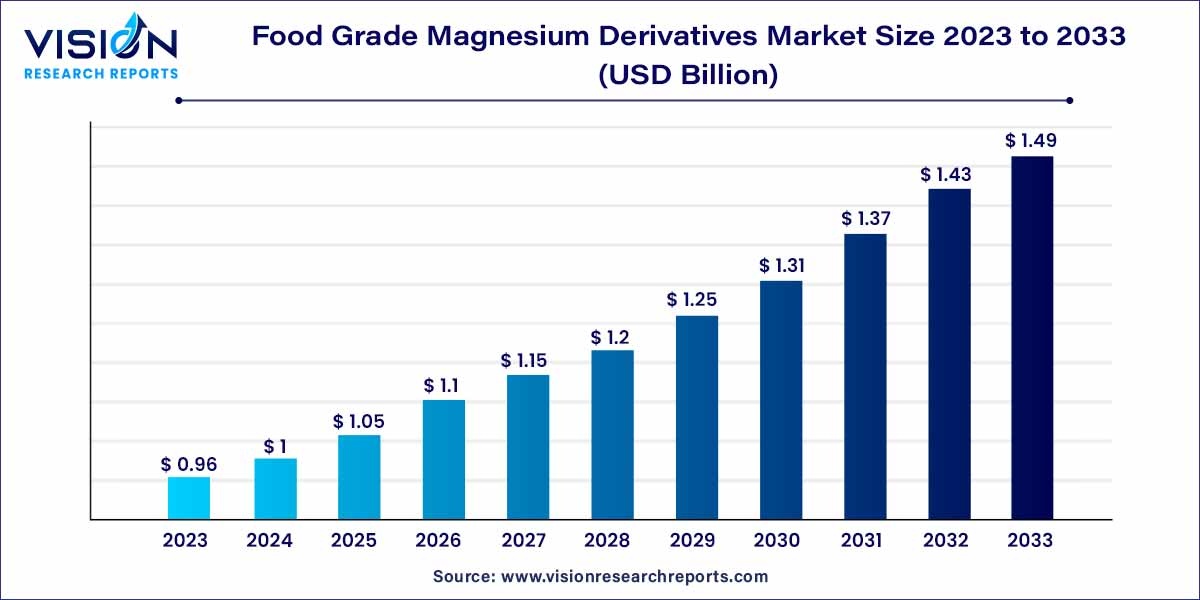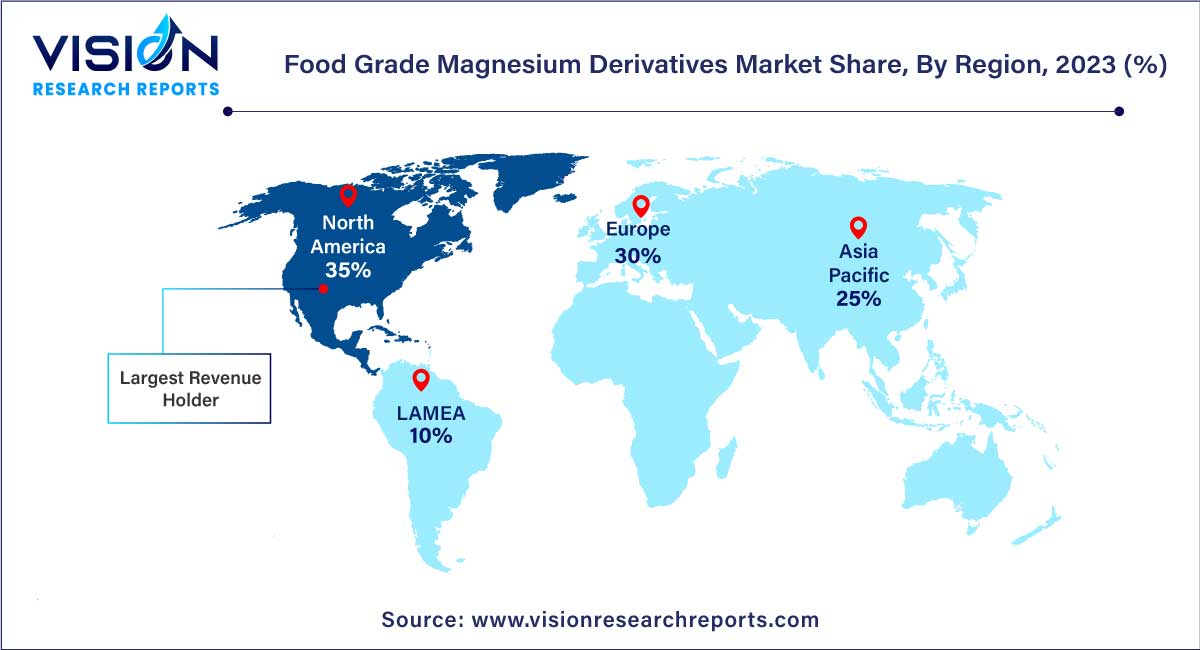The global food grade magnesium derivatives market size was estimated at USD 0.96 billion in 2023 and it is expected to surpass around USD 1.49 billion by 2033, poised to grow at a CAGR of 4.52% from 2024 to 2033. The food grade magnesium derivatives market has experienced significant growth in recent years, driven by the increasing demand for high-quality, nutritionally enhanced food products.

Magnesium, an essential mineral, plays a pivotal role in various bodily functions, making it a valuable ingredient in the food industry. This overview provides insight into the key aspects shaping the food grade magnesium derivatives market.
The growth of the food grade magnesium derivatives market can be attributed to several key factors. Firstly, the increasing awareness among consumers about the importance of magnesium in maintaining good health has led to a growing demand for magnesium-fortified food products. Additionally, the rising trend of clean label and natural ingredients in food products has driven manufacturers to incorporate food grade magnesium derivatives, further fueling market growth. Moreover, the expanding application of these derivatives in various food categories such as bakery, dairy, and beverages has significantly contributed to the market's expansion. Stringent regulations and standards imposed by regulatory authorities to ensure the quality and safety of these derivatives have also bolstered market growth, instilling consumer confidence. Furthermore, the ongoing innovations in food processing technologies have enabled the development of new and diverse products, providing consumers with a wide range of options. These factors combined have created a conducive environment for the growth of the food grade magnesium derivatives market, offering both health-conscious consumers and manufacturers a mutually beneficial solution.
| Report Coverage | Details |
| Growth Rate from 2024 to 2033 | CAGR of 4.52% |
| Market Revenue by 2033 | USD 1.49 billion |
| Revenue Share of North America in 2023 | 35% |
| CAGR of Asia Pacific from 2024 to 2033 | 4.06% |
| Base Year | 2023 |
| Forecast Period | 2024 to 2033 |
| Market Analysis (Terms Used) | Value (US$ Million/Billion) or (Volume/Units)Companies Covered |
The inorganic segment accounted for the highest revenue share of 57% in 2023. Inorganic magnesium derivatives, such as magnesium carbonate and magnesium hydroxide, are widely utilized for their neutralizing and buffering properties. They play a crucial role in regulating the pH levels in various food products, including bakery items, dairy products, and beverages. Additionally, inorganic magnesium derivatives are known for their anti-caking and anti-moisture properties, enhancing the texture and shelf life of processed foods.
The organic segment is expected to grow at a CAGR of 4.35% during the forecast period. Organic magnesium derivatives, including magnesium citrate and magnesium aspartate, are valued for their bioavailability and assimilation by the human body. These derivatives are commonly used in dietary supplements and nutraceuticals, providing a readily absorbable form of magnesium. Organic magnesium compounds are preferred in the formulation of health supplements due to their ease of digestion and minimal gastrointestinal irritation. Moreover, organic magnesium derivatives are often incorporated into functional foods, addressing magnesium deficiency in individuals following specific dietary patterns or restrictions.
The food segment held the largest revenue share of 67% in 2023. In the food sector, magnesium derivatives are widely employed as additives in bakery products. They act as stabilizers, aiding in maintaining the freshness and texture of baked goods. Additionally, magnesium derivatives serve as anti-caking agents, ensuring the proper flow and consistency of powdered products such as spices, seasoning blends, and baking mixes. In processed foods, these derivatives contribute to improving shelf life, preventing moisture absorption, and preserving the food's quality during storage and transportation.
In the beverage industry, food grade magnesium derivatives find extensive use in both non-alcoholic and alcoholic beverages. Magnesium compounds are incorporated into sports and energy drinks to replenish electrolytes lost during physical activities. These derivatives also act as pH regulators in various beverages, ensuring the right balance of acidity and enhancing the overall taste profile. Moreover, magnesium-fortified water and juices cater to health-conscious consumers seeking functional beverages with added nutritional benefits. The neutral taste of magnesium derivatives allows for their seamless integration into a wide range of beverages without compromising the original flavor.
North America dominated the global market with the largest market share of 35% in 2023. In North America, the market is driven primarily by the increasing demand for health-conscious food products. With consumers in this region becoming increasingly aware of the importance of a balanced diet, the incorporation of magnesium derivatives in various foods and beverages has gained traction. Furthermore, stringent regulatory frameworks and a robust food processing industry have contributed to the steady growth of the market in North America.

Europe is predicted to grow at a CAGR of 4.06% during the forecast period. Europe, with its emphasis on clean label and organic products, has witnessed a surge in the demand for food grade magnesium derivatives. The region's food manufacturers are focusing on natural ingredients, driving the use of organic magnesium derivatives in their products. Additionally, the European market benefits from extensive research and development activities, leading to innovations in magnesium-fortified foods and beverages. The presence of a health-conscious consumer base and a well-established food industry further propels market growth in Europe.
By Product
By Application
By Region
Chapter 1. Introduction
1.1. Research Objective
1.2. Scope of the Study
1.3. Definition
Chapter 2. Research Methodology
2.1. Research Approach
2.2. Data Sources
2.3. Assumptions & Limitations
Chapter 3. Executive Summary
3.1. Market Snapshot
Chapter 4. Market Variables and Scope
4.1. Introduction
4.2. Market Classification and Scope
4.3. Industry Value Chain Analysis
4.3.1. Raw Material Procurement Analysis
4.3.2. Sales and Distribution Channel Analysis
4.3.3. Downstream Buyer Analysis
Chapter 5. COVID 19 Impact on Food Grade Magnesium Derivatives Market
5.1. COVID-19 Landscape: Food Grade Magnesium Derivatives Industry Impact
5.2. COVID 19 - Impact Assessment for the Industry
5.3. COVID 19 Impact: Global Major Government Policy
5.4. Market Trends and Opportunities in the COVID-19 Landscape
Chapter 6. Market Dynamics Analysis and Trends
6.1. Market Dynamics
6.1.1. Market Drivers
6.1.2. Market Restraints
6.1.3. Market Opportunities
6.2. Porter’s Five Forces Analysis
6.2.1. Bargaining power of suppliers
6.2.2. Bargaining power of buyers
6.2.3. Threat of substitute
6.2.4. Threat of new entrants
6.2.5. Degree of competition
Chapter 7. Competitive Landscape
7.1.1. Company Market Share/Positioning Analysis
7.1.2. Key Strategies Adopted by Players
7.1.3. Vendor Landscape
7.1.3.1. List of Suppliers
7.1.3.2. List of Buyers
Chapter 8. Global Food Grade Magnesium Derivatives Market, By Product
8.1. Food Grade Magnesium Derivatives Market, by Product, 2024-2033
8.1.1. Inorganic
8.1.1.1. Market Revenue and Forecast (2021-2033)
8.1.2. Organic
8.1.2.1. Market Revenue and Forecast (2021-2033)
8.1.3. Magnesium Chelates
8.1.3.1. Market Revenue and Forecast (2021-2033)
Chapter 9. Global Food Grade Magnesium Derivatives Market, By Application
9.1. Food Grade Magnesium Derivatives Market, by Application, 2024-2033
9.1.1. Food
9.1.1.1. Market Revenue and Forecast (2021-2033)
9.1.2. Beverages
9.1.2.1. Market Revenue and Forecast (2021-2033)
Chapter 10. Global Food Grade Magnesium Derivatives Market, Regional Estimates and Trend Forecast
10.1. North America
10.1.1. Market Revenue and Forecast, by Product (2021-2033)
10.1.2. Market Revenue and Forecast, by Application (2021-2033)
10.1.3. U.S.
10.1.3.1. Market Revenue and Forecast, by Product (2021-2033)
10.1.3.2. Market Revenue and Forecast, by Application (2021-2033)
10.1.4. Rest of North America
10.1.4.1. Market Revenue and Forecast, by Product (2021-2033)
10.1.4.2. Market Revenue and Forecast, by Application (2021-2033)
10.2. Europe
10.2.1. Market Revenue and Forecast, by Product (2021-2033)
10.2.2. Market Revenue and Forecast, by Application (2021-2033)
10.2.3. UK
10.2.3.1. Market Revenue and Forecast, by Product (2021-2033)
10.2.3.2. Market Revenue and Forecast, by Application (2021-2033)
10.2.4. Germany
10.2.4.1. Market Revenue and Forecast, by Product (2021-2033)
10.2.4.2. Market Revenue and Forecast, by Application (2021-2033)
10.2.5. France
10.2.5.1. Market Revenue and Forecast, by Product (2021-2033)
10.2.5.2. Market Revenue and Forecast, by Application (2021-2033)
10.2.6. Rest of Europe
10.2.6.1. Market Revenue and Forecast, by Product (2021-2033)
10.2.6.2. Market Revenue and Forecast, by Application (2021-2033)
10.3. APAC
10.3.1. Market Revenue and Forecast, by Product (2021-2033)
10.3.2. Market Revenue and Forecast, by Application (2021-2033)
10.3.3. India
10.3.3.1. Market Revenue and Forecast, by Product (2021-2033)
10.3.3.2. Market Revenue and Forecast, by Application (2021-2033)
10.3.4. China
10.3.4.1. Market Revenue and Forecast, by Product (2021-2033)
10.3.4.2. Market Revenue and Forecast, by Application (2021-2033)
10.3.5. Japan
10.3.5.1. Market Revenue and Forecast, by Product (2021-2033)
10.3.5.2. Market Revenue and Forecast, by Application (2021-2033)
10.3.6. Rest of APAC
10.3.6.1. Market Revenue and Forecast, by Product (2021-2033)
10.3.6.2. Market Revenue and Forecast, by Application (2021-2033)
10.4. MEA
10.4.1. Market Revenue and Forecast, by Product (2021-2033)
10.4.2. Market Revenue and Forecast, by Application (2021-2033)
10.4.3. GCC
10.4.3.1. Market Revenue and Forecast, by Product (2021-2033)
10.4.3.2. Market Revenue and Forecast, by Application (2021-2033)
10.4.4. North Africa
10.4.4.1. Market Revenue and Forecast, by Product (2021-2033)
10.4.4.2. Market Revenue and Forecast, by Application (2021-2033)
10.4.5. South Africa
10.4.5.1. Market Revenue and Forecast, by Product (2021-2033)
10.4.5.2. Market Revenue and Forecast, by Application (2021-2033)
10.4.6. Rest of MEA
10.4.6.1. Market Revenue and Forecast, by Product (2021-2033)
10.4.6.2. Market Revenue and Forecast, by Application (2021-2033)
10.5. Latin America
10.5.1. Market Revenue and Forecast, by Product (2021-2033)
10.5.2. Market Revenue and Forecast, by Application (2021-2033)
10.5.3. Brazil
10.5.3.1. Market Revenue and Forecast, by Product (2021-2033)
10.5.3.2. Market Revenue and Forecast, by Application (2021-2033)
10.5.4. Rest of LATAM
10.5.4.1. Market Revenue and Forecast, by Product (2021-2033)
10.5.4.2. Market Revenue and Forecast, by Application (2021-2033)
Chapter 11. Company Profiles
11.1. Grecian Magnesite
11.1.1. Company Overview
11.1.2. Product Offerings
11.1.3. Financial Performance
11.1.4. Recent Initiatives
11.2. Sinwon Beverages Co., Ltd.
11.2.1. Company Overview
11.2.2. Product Offerings
11.2.3. Financial Performance
11.2.4. Recent Initiatives
11.3. Compass Minerals
11.3.1. Company Overview
11.3.2. Product Offerings
11.3.3. Financial Performance
11.3.4. Recent Initiatives
11.4. OLE Chemical Co., Ltd.
11.4.1. Company Overview
11.4.2. Product Offerings
11.4.3. Financial Performance
11.4.4. LTE Scientific
11.5. Martin Marietta Magnesia Specialties
11.5.1. Company Overview
11.5.2. Product Offerings
11.5.3. Financial Performance
11.5.4. Recent Initiatives
11.6. Ibar Northeast
11.6.1. Company Overview
11.6.2. Product Offerings
11.6.3. Financial Performance
11.6.4. Recent Initiatives
11.7. NikoMag
11.7.1. Company Overview
11.7.2. Product Offerings
11.7.3. Financial Performance
11.7.4. Recent Initiatives
11.8. K + S Aktiengesellschaft
11.8.1. Company Overview
11.8.2. Product Offerings
11.8.3. Financial Performance
11.8.4. Recent Initiatives
11.9. Oksihim, Ltd.
11.9.1. Company Overview
11.9.2. Product Offerings
11.9.3. Financial Performance
11.9.4. Recent Initiatives
11.10. Hawkins
11.10.1. Company Overview
11.10.2. Product Offerings
11.10.3. Financial Performance
11.10.4. Recent Initiatives
Chapter 12. Research Methodology
12.1. Primary Research
12.2. Secondary Research
12.3. Assumptions
Chapter 13. Appendix
13.1. About Us
13.2. Glossary of Terms
 Cross-segment Market Size and Analysis for
Mentioned Segments
Cross-segment Market Size and Analysis for
Mentioned Segments
 Additional Company Profiles (Upto 5 With No Cost)
Additional Company Profiles (Upto 5 With No Cost)
 Additional Countries (Apart From Mentioned Countries)
Additional Countries (Apart From Mentioned Countries)
 Country/Region-specific Report
Country/Region-specific Report
 Go To Market Strategy
Go To Market Strategy
 Region Specific Market Dynamics
Region Specific Market Dynamics Region Level Market Share
Region Level Market Share Import Export Analysis
Import Export Analysis Production Analysis
Production Analysis Others
Others